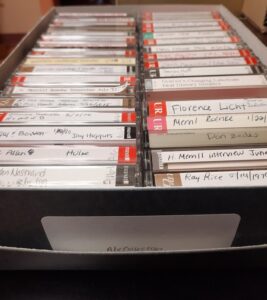Why Don’t We Just Digitize Everything?
By Becky Chapin, Archivist
These days there is a podcast for everything and in this time of working from home I’ve found several archive related podcasts that have been very interesting. The latest is called ‘Material Memory’ by the Council on Library and Information Resources (CLIR). The introductory episode is called “Keeping Cultural Memory Alive: What is at Stake?” and it touches on the subject of digitization and its fragility.
Late into the episode, the interviewer asks the interviewee about the threat of the loss of digital information. It’s a subject that has been in the background of many digitization projects I’ve learned about in the past and something that came up in the process of writing our own digital preservation policy. In workshops and webinars, I’ve heard presenters say that people thought that digitizing items meant we could throw away originals and save space…every person in the room gasped.

1960 Census blanks arrive in Geneva
I’m sure people would like to think that digitization or newer technology is the answer to everything, but it’s just not the case. For example, the interviewee brings up the case of the 1960 US census:
The 1960 census was done using a particular kind of punch card. So all the information that was gathered from the census was reinterpreted into punch cards and then used and analyzed. In the mid-80s, there was a reason to go back and review this data—parts of this data—and the U.S. Government Census Bureau discovered that there was not a single machine in the United States that could read those punch cards, that that technology had become obsolete, and our government agents I believe had to go to Tokyo—there was a technology museum—and found the machine that could read that information. That’s census information that was out of reach and completely inaccessible. Fortunately, there was recourse to a machine in another country.
Remember floppy disks? We have a few floppy disks in our collection and we only have one computer in our building that has a floppy disk reader and it may or may not work. What’s on those disks? Well, three aren’t labeled so I couldn’t tell you until we figure out how to read the disk.

Digitizing our cassette tapes with a USB capture
What about cassette tapes? We’re currently digitizing our cassette collection thanks to the Rochester Regional Library Council who purchased a converter for use by its members. But we still have many audio reels that were not converted to cassettes, its knowledge lost until we can find funding and a vendor to digitize the reels. Floppy disks, audio reels, CD-ROMS, cassette tapes…they’re all technology that has been the storage solution in their time periods and are now obsolete or close to obsolete. The same goes for computers.
We know that digital information is vulnerable not only because it’s kept on fragile media, but also because it’s literally ones and zeros that can’t be interpreted without the right hardware and software, which changes quickly in today’s world. And, increasingly, what we create today is in digital formats. So, as CLIR works to make knowledge more accessible by supporting digitization and digital infrastructure, we also know that digital information is especially vulnerable.
Like the interviewer says, all our digital material is in ones and zeros that can only be read on particular technology. I came across the term ‘bit rot’ in a digital preservation class a few years ago. It’s defined under data degradation which is the gradual corruption of computer data due to failures in a data storage device. Essentially, anything stored digitally (ex. in a cloud), on flash drives, CDs, floppy disks, etc. are all vulnerable to degradation and if we, as archivists, don’t constantly manage our digital files, the information could be lost forever.
 We can see a piece of paper degrading before our eyes, but we can’t see a file degrading because it’s made up of zeros and ones. What happens when you’re storing files on a cloud system and the company shuts down abruptly? Data servers themselves are a larger contributor to the pollution problem, how do we store our digital files safely but not impact the climate?
We can see a piece of paper degrading before our eyes, but we can’t see a file degrading because it’s made up of zeros and ones. What happens when you’re storing files on a cloud system and the company shuts down abruptly? Data servers themselves are a larger contributor to the pollution problem, how do we store our digital files safely but not impact the climate?
So is digitization the answer? It certainly gives us an avenue for opening up access to those who could not gain access otherwise. It’s become an important tool for many research institutions during this pandemic in being able to provide people with answers to their questions even if they can’t visit. Our materials tell Geneva’s stories but when they’re sitting in storage we can’t share all the fascinating things we have. Digitizing them gives them new life while preserving the physical state of the original. While digitization might not be the final solution to preservation, it is certainly our answer right now and as archivists we all work hard to ensure longevity.

That’s a great analysis of the conundrum.
I agree 100%, Becky. Digitization dramatically expands discovery and access and helps preserve the original through less handling. But, we must retain the originals. Plus there are some aspects of the original that can’t be captured digitally.